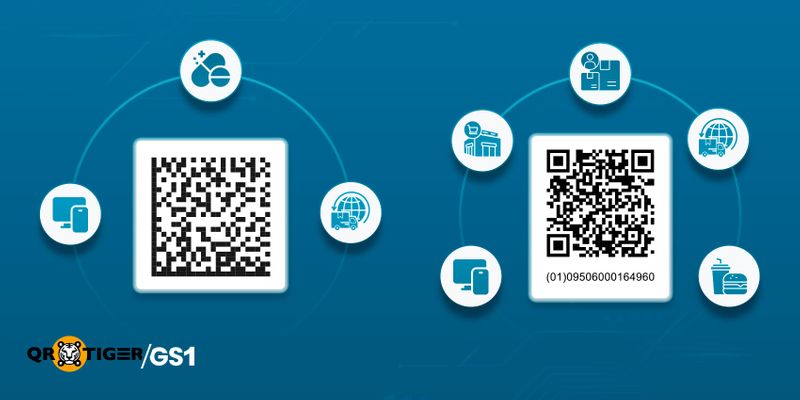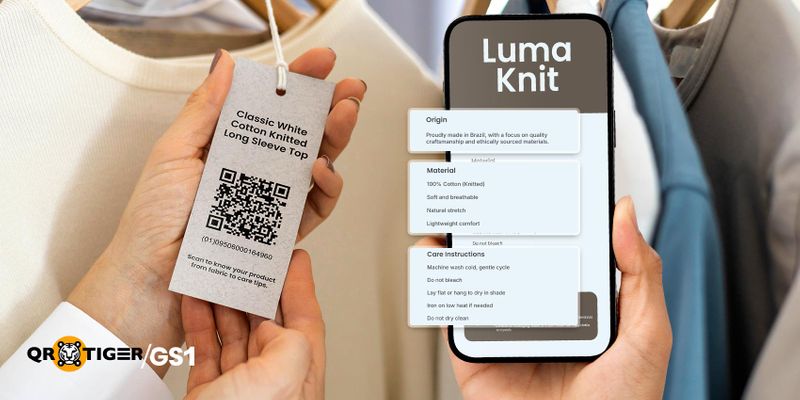GS1 Brazil: Driving Innovation in Supply Chain Standards

Accurate product identification and efficient data sharing are essential for businesses to operate efficiently. GS1 standards in Brazil play a vital role in optimizing supply chains by improving transparency, enabling precise tracking, and fostering trust among industry partners.
These standardized solutions enhance traceability, automation, and inventory management, helping industries optimize operations and adapt to market demands. The article explores how GS1 in Brazil transforms supply chains through innovative technologies and industry collaborations.
Table of Contents
What is GS1 Brazil?
GS1 Brazil / Brasil (BR) or Brazilian Automation Association is part of a neutral, non-profit organization that develops and maintains the most widely used global standards for efficient business communication, contributing to the automation of supply chains, from raw materials to the final consumer.
Established on November 8, 1983, it was originally known as the Brazilian Association of Commercial Automation (Associação Brasileira de Automação Comercial - ABAC). The initiative was led by the Special Secretariat of Informatics (SEI), which invited trade sector companies to assess and identify industry needs at the time.
By adopting these standards and solutions, businesses can obtain multiple benefits, including:
- Automated processes for improved efficiency
- Improved product traceability throughout the supply chain
- Stronger anti-piracy measures to protect authenticity
- Verified product origins to ensure consumer trust
- Faster operations, from point of sale transactions to inventory management
- Reduced errors in logistics and data handling
Address: Av. Brig. Faria Lima, 328 – Pinheiros, 05426-200, São Paulo – SP, Brazil
Contact no: +55 11 97491-7974 / +55 11 4000-1936
Email: atendimento@gs1br.org
Introduced initiatives and collaborated campaigns
GS1 BR has actively driven industry advancements by introducing groundbreaking initiatives that improve supply chain efficiency. It has fostered innovation and strengthened compliance across various sectors through strategic collaborations and coordinated campaigns.
1) GS1 Ventures
GS1 Brasil Ventures is the corporate venture initiative, designed to accelerate high-impact startups in logistics, supply chain, and digital commerce. It targets scale-up companies with solutions in traceability, automation, sustainability, and e-commerce.
In addition to investment, it connects startups with GS1’s ecosystem of over 59,000 members, offering mentorship, pilot access, and integration with leading market players.
The program represents GS1 BR’s vision for open innovation and digital transformation, empowering startups through education, data infrastructure, and strategic collaboration. It aligns with GS1’s global goal: to facilitate efficient, secure, and interoperable supply chains powered by technology and shared standards.
2) GS1 BR Partner Program
The Partner Program connects GS1 BR with solution providers, consultants, and technology integrators who champion GS1 standards across industries. Partners gain visibility via GS1 platforms, exclusive training, and opportunities to work together on impactful projects.
With tiered benefits—Bronze, Silver, and Gold, the program provides enhanced technical support, promotional access, and innovation engagement.
By partnering with tech vendors and data experts, the program strengthens GS1’s leadership in digital transformation. Partners are recognized as reliable growth drivers of product identification, traceability, and supply chain optimization. Hence, this initiative fosters a collaborative, adaptive, and innovative GS1 ecosystem.
3) GS1 BR Consulting
GS1 BR Consulting provides in-depth guidance to help businesses adopt traceability standards and simplify global identification. Its services include barcode optimization, GTIN allocation, data validation, and compliance guidance.
It provides custom advisory programs through which GS1 consultants minimize errors, streamline operations, and improve supply chain visibility.
4) Cadastro Nacional de Produtos (CNP)
GS1 BR launched the Cadastro Nacional de Produtos (CNP) platform in 2013 to streamline data management and product registration across the supply chain. By allowing automatic generation of GTINs and linking them with GLNs, it assists businesses efficiently register, label, and manage product information.
More than 27,000 companies use this platform to manage more than 13.5 million products. The benefits of using this platform include reduced operational costs and improved data accuracy across manufacturing, distribution, and retail.
A key innovation within CNP is the integration of GS1’s Global Product Classification (GPC) standard, which became mandatory in 2016. GPC ensures consistent product categorization, allowing stakeholders to easily understand and exchange product data.
Since 2018, Brazil’s Treasury Department has authorized GTINs and GPC codes in electronic invoices through GS1 BR’s BR’s database as a national reference. This highlights the CNP’s role in improving transparency and market access.
5) Coca-Cola & OPTEL Group: Sustainable supply chain innovation
The Brazilian subsidiary of GS1 honored the collaborative efforts of OPTEL and Coca-Cola with the Automation Award in the Sustainability category. The partnership of OPTEL and Coca-Cola revolutionized the management of returnable bottles with supply chain digitization and traceability technologies.
OPTEL’s advanced traceability platform, named Optchain, helps Coca-Cola track each returnable bottle's history, number of cycles, and lifecycle. Using GS1-powered coding systems, Coca-Cola improved traceability and fleet management, optimizing bottle reuse cycles and reducing waste.
6) Coca-Cola Latin America: QR codes for refillable bottles
The GS1 BR helped Coca-Cola Latin America implement QR codes powered by GS1 to track the lifecycle of refillable bottles. This initiative supports Coca-Cola’s goal of selling 40% of beverages in refillable bottles by 2030, improving sustainability and supply chain transparency.
Coca-Cola’s collaboration with GS1 and its technology partners demonstrates the power of combining trusted data, cutting-edge technology, and a commitment to responsible practices.
Through the application of QR codes powered by GS1, Coca-Cola has made significant strides in advancing its refillable bottle initiative, reducing waste, and demonstrating how GS1 standards can drive efficiency and traceability in production and supply chains.
GS1 Sunrise 2027 is the global industry initiative to adopt 2D barcodes in supply chain systems and point-of-sale (POS). The transition from traditional 1D barcodes (like UPC/EAN) to 2D barcodes (like GS1 Data Matrix and GS1 QR code) has already started in several countries, including Germany, Canada, etc., and across industries.
This shift is not a mandate. It's being introduced as a new option that's better suited for the data-sharing requirements of industries today.
GS1 doesn’t provide 2D barcode generation services. Companies can approach a GS1 member organization for guidance on following and developing their barcodes; alternatively, they can use third-party services, like the GS1 QR code generator by QR Tiger.
How do GS1 Standards support industries across Brazil?

Let’s understand how these standards optimize the operations of industries in Brazil.
Retail and e-commerce
GS1 BR helps solve retail challenges with smart solutions that improve product tracking, inventory accuracy, shelf management, and loss prevention while decreasing errors and strengthening digital system integration.
These standards help cut waste, increase efficiency, simplify operations, and enhance customer experiences. For example, scanning a GS1 2D barcode can reveal comprehensive product details, including product origin and expiration, ensuring a better consumer experience.
Food
Brazil is a top five producer of 34 agricultural commodities.
GS1 standards help strengthen consumer trust with clear and detailed food labels, ensuring quality and traceability throughout the supply chain. They help businesses optimize operations and boost productivity.
GS1 Digital Link QR code simplifies access to key product details in a single scan, allowing consumers to check ingredient origins, view nutritional information, and discover usage tips and recipes.
Pharmaceutical
The standards help the pharmaceutical and healthcare industries improve traceability, productivity, and patient safety.
They ensure accurate product identification, facilitating safer processes and better data management. GS1 DataMatrix integrates batch numbers, Global Trade Item Numbers (GTINs), expiration dates, and serialization to reduce errors and comply with regulations.
The GS1 DataMatrix barcode on medicine packaging enhances drug traceability, ensuring improved safety for patients.
Fashion

QR codes make product information more transparent and interactive, facilitating consumers with easy access to product origin, composition, or care details.
By using a GS1 QR code for inventory management in apparel and fashion, businesses can maintain real-time inventory visibility to ensure products’ availability both in stores and online. EPC/RFID and GTIN technology help track items from origin to destination, enhancing traceability.
Personalized product details enhance the shopping experience, boosting search and sales results. EPC/RFID standards enhance inventory accuracy, helping businesses achieve up to 95% stock accuracy for smooth operations.
Success Stories from GS1 Br
Here are some real-life use cases:
1) Via Marte Brazil boosted consumer engagement
Via Marte, a shoe manufacturer, presents an extensive variety of products. Its fast product renewal cycles made it challenging to efficiently manage operations and logistics. It used GS1 BR to identify individual products and their movements across the supply chain with high levels of data availability.
Implementing these standards benefited Via Marte 100% with accurate real-time inventory data, a 4% reduction in shipping costs, highly efficient stock management, and more.
2) Green Code Project automated tree tracking
Legado das Águas, Brazil’s largest private Atlantic Forest reserve, partnered with the GS1 BRon the Green Code Project to automate tree tracking. Trees were tagged with QR codes carrying a GTIN, lot number, and location. Their seeds were then collected and sent to the reserve’s nursery.
When the seedlings grew into plants ready for sale, they got QR code labels linking them to their original tree. With GS1 Digital Link technology, buyers can scan the code through a smartphone to trace the tree’s origin and characteristics.
This project replaced manual environmental tracking with an automated system, speeding up the process and reducing mistakes.
How does GS1 BR shape the future of supply chain innovation?
By 2030, Brazil's supply chain management market is expected to grow to US$ 1,192.5 million, with an estimated 12.4% annual growth rate from 2024 onward.
GS1 BR prioritizes innovation by tracking market trends and creating better solutions. With the growing demand for real-time product data, the member organization of GS1 is launching data qualification services to ensure accurate information across industries.
Traceability is a key focus, improving product security for consumers. They also invest in training and education, providing technical knowledge to businesses through research and content releases.
Additionally, the GS1 BR continues investing in automation to optimize operations, enhance control, and boost supply chain efficiency across different sectors.
A Guide to registering with GS1 BR
Registering with GS1 BR is essential for assigning globally recognized product identifiers (like barcodes and GTINs). Here are the steps involved:
Step 1: Pre-Registration
Visit the pre-registration page on the GS1 BR portal and create your credentials. You need to fill in details like:
- Company type (individual or legal entity)
- CPF or CNPJ (Brazilian tax ID)
- Basic details like name, email, and password
- Annual turnover (optional)
Step 2: Select the membership
GS1 BR provides various membership plans as per barcode needs and your company size. You need to choose the number of products you want to register and the type of GS1 identifiers required (for example, GTIN, GLN)
Step 3: Submit documents
You will be asked to upload the following documents:
- Company registration documents
- Proof of tax ID (CPF or CNPJ)
- Product details (name, packaging type, category)
Step 4: Fee payment to get a GS1 Company Prefix
Fees differ based on the company size and the number of identifiers required. Once you pay the fees and your registration is approved, GS1 BR will issue your GS1 Company Prefix that helps you create GTINs, GLNs, barcodes, and QR codes.
Step 5: Access CNP Platform
You can use the GS1 Brazil’s Cadastro Nacional de Produtos (CNP) platform to:
- Generate barcodes and GTINs
- Manage product data and attributes
- Print labels and track product registration
Step 6: Begin using GS1 standards
With the GS1 Company Prefix, you can assign GTINs to products and integrate barcodes into packaging.
Harness GS1 BR for Efficient Supply Chain
GS1 Brazil plays a vital role in modernizing supply chain operations by implementing globally recognized standards that enhance connectivity and efficiency. By leveraging GS1 standards, businesses across Brazil can improve product traceability, simplify logistics, and optimize inventory management, ensuring smoother transactions from manufacturers to consumers.
Adopting the GS1 local chapter’s innovative solutions empowers companies to stay competitive in an evolving market and build trust with consumers. A business entity can join the GS1 BR to ensure smooth integration of GS1-compliant QR codes and improved workflow.
FAQs
Why are QR codes better than 1D barcodes?
QR codes hold more data, work even if partially damaged, and scan from any angle. They're ideal for linking to websites, tracking, and storing detailed product info, far beyond what 1D barcodes like UPC or EAN can carry.
Does shifting to 2D barcodes increase GS1 membership fees?
No additional costs are involved for GS1 membership in Brazil. The same IDs used today, such as the GTIN, can be used in 1D (EAN-13) or 2D (GS1 DataMatrix and GS1 Standard QR Code) codes.
How long will 1D barcodes remain in use?
1D (linear) barcodes such as EAN/UPC will continue to be used. GS1’s Sunrise 2027 initiative encourages the adoption of 2D barcodes at point-of-sale to facilitate richer product data and digital experiences, but 1D barcodes are not phased out. Businesses may choose to use 1D, 2D, or both based on their operational needs.
DISCLAIMER: We acknowledge that GS1, as well as the materials, proprietary items, and all related patents, copyright, trademark, and other intellectual property (collectively, “intellectual property”) relating to its use, are the property of GS1 Global, and that our use of the same shall be in accordance with the conditions provided by GS1 Global.




